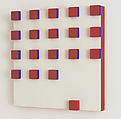Relevo (Relief)
Lygia Pape Brazilian
Not on view
After World War II, Brazil underwent a period of rapid industrialization and development, epitomized by the inauguration in 1960 of a new modern capital, Brasília. Lygia Pape took part in the effervescent cultural milieu of the time, which enthusiastically embraced the legacies of European modernism. In particular, she engaged the vocabulary of the Concrete art movement as a member of Grupo Frente (1954–57), a coalition of artists practicing a trend in abstraction based on geometric forms and pure colors. Relevo (Relief) is a key example of Pape’s involvement in this group. A series of nineteen red squared pieces are aligned over a white surface. Equidistant from each other, the composition follows a rigid and methodic system, suggesting an affinity to industrial patterns. From a technical perspective, the work looks machine-made, which is aligned with the intentions of the Concrete artists. The color of the sides of the relief pieces contrasts with that of the front, emphasizing the optical effect of the composition which looks as though it is coming out of the wall into the real space of the viewer. Here Pape was questioning the two-dimensional conventions of the picture plane.
This image cannot be enlarged, viewed at full screen, or downloaded.

